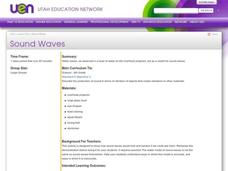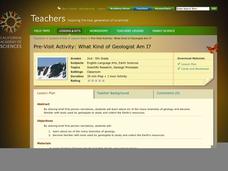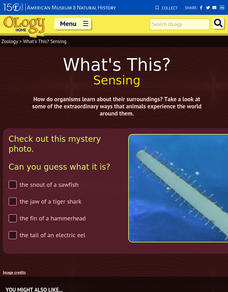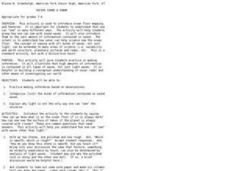Curated OER
Waves Interference
Learners identify different wave types and their characteristics. For this wave lesson students complete activities by activating tuning forks and interpreting data.
Curated OER
Characteristics of Waves
For this characteristics of waves worksheet, learners answer 9 questions about the structure of waves, the types of waves and the components of waves. They describe the frequency of a wave and calculate the velocity and frequency of waves.
Curated OER
Fundamental Properties of a Wave
Students investigate the form and motion of a wave, and examine the fundamental properties of wavelength, frequency, and amplitude. They discuss the fundamental properties of a wave, and in small groups conduct an experiment involving...
Curated OER
Seismic Waves
In this seismic waves learning exercise, student will read information about the different types of waves that occur during an earthquake: P (Primary) waves, S (Secondary) waves, and shear waves. Then students will complete 2 short...
Curated OER
Fetch Me a Wave
Learners explore waves and how they form. In this wave lesson students prepare a written report on waves and tsunamis then discuss what they learned.
Curated OER
What are Earthquakes?
Here is a scientific presentation of earthquakes. The elastic rebound theory is explained, as well as the different types of waves and how they are measured. Just a note: Slide number 15 has a diagram that is upside down. Enable editing...
Curated OER
Two Source Interference
The paths of waves generated from two different points are shown here on a sequence of slides. The lengths and directions are labeled, step-by-step. Finally, path interference is shown along with the calculations that your physics...
Curated OER
A House is a House for Me: Library Skills for Young Readers
Read Mary Ann Hoberman's book A House is a House for Me to introduce the idea that a library is a house for shelves of books. Young readers practice alphabetizing in the picture book (easy fiction) section of the library. They learn how...
Curated OER
Waves Worksheet
For this frequency worksheet, students answer 10 questions about frequency and waves. The name of a teach appears at the top of this page.
Curated OER
Earthquakes: First Grade Lesson Plans and Activities
First graders explore how earthquakes release energy in a set of hands-on activities. During the pre-lab, they discover how energy from an earthquake releases waves through the earth using a water-filled cup and...
Chymist
Make a Low Energy Radio Transmitter
How do you demonstrate radio transmissions? Pupils build a low-energy radio transmitter by constructing two coils from magnet wire and connecting them to audio/phone plugs. The resource provides the details on how to build the...
Curated OER
Sound Waves
Students observe how sound waves would look and behave if we could see them. They determine ways the model is accurate and inaccurate based on actual sound waves.
Curated OER
Standing Waves
In this standing waves activity, high schoolers read about standing waves, their nodes, their anti-nodes and their wavelengths. They are given diagrams of harmonics and the equation to find the frequency of harmonics. Students match...
Curated OER
Sound Waves
Students explore sound. In this "sound" science lesson, students define sound and explain how sound travels. Students experiment with paper cups and string to conclude how sound travels. Students research a chosen aspect of sound with a...
University of Southern California
Wave Erosion Lab
Using a stream table, erosion enthusiasts examine how the density of sediment and how the slope of land contribute to the amount moved by waves. You will not be able to use this entire resource as is; there are teachers' names and...
Curated OER
Light and Elements
Here is a full-fledged investigation of light waves, the electromagnetic spectrum, and element spectra. Physicists research a scientist that contributed to our understanding of the behavior of light. They take notes on your lecture, and...
Curated OER
Physics 152 ~ Fall 2003 Midterm Exam #3, Parts A, B
Illuminated physics stars show what they know about light by taking this exam. They match several related vocabulary terms to descriptions and answer multiple choice questions about the characteristics of light, magnification, and...
Curated OER
The Poetry Archive
Listening to poems about feeling lonely and feeling like an outsider set the stage for a group activity that focuses on Stevie Smith's "Not Waving But Drowning." Groups examine the three stanzas of Smith's poem separately and identify in...
Colorado State University
Why Are Clouds White?
Is it possible to change the color of clouds? A three-part activity explores the scattering of light by the water droplets that make up clouds. After observing a demonstration, curious scholars conduct their own investigations of the...
California Academy of Science
What Kind of Geologist Am I?
Transform your class into young geologists as they learn about six different branches of geology. Using the included geology career descriptions and picture cards, learners work in small groups deciding which tools and locations fit...
American Museum of Natural History
What's This? Sensing
There is a scallop that relies on sight so much that it actually has more than 100 eyes! There are many species that rely heavily on one sense or another. An online interactive resource has youth read about several of these animals. The...
Curated OER
Seeing Sound & Sonar
Learners make inferences based on different sounds that they hear. In this inferences lesson plan, students will hear sounds of different objects and describe the sounds based on what they hear. They will answer various questions about...
Curated OER
Color at Light Speed
Rainbow science anyone? learners put the color specturm, frequency, light waves, and wavelengths into a light speed context. They use algebraic formulas to determine the speed of each light wave length. A great way to connect math and...
Curated OER
Sounds like Science
Second graders create sound effects to produce a radio drama. In this sound lesson, 2nd graders read a book and provide the sound effects to transform it into a radio drama. They discuss sound and the shape of sound waves based on their...























